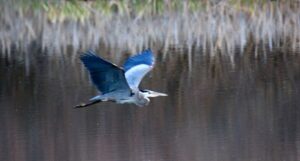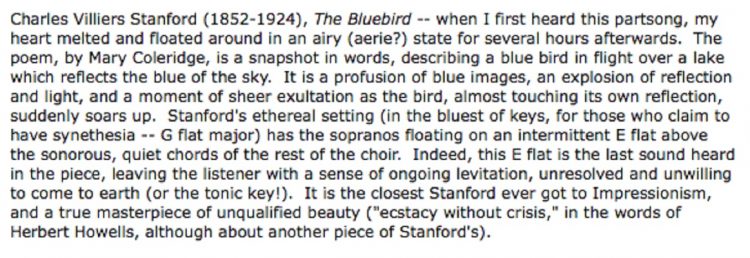
I’ve written about bluebirds before, when I asked why Uncle Remus had a bluebird on his shoulder in the song “Zip-A-Dee-Doo-Dah,” and I revisited that image when I talked about “Over the Rainbow.” Now I want to re-revisit the topic in a short post about the short piece “The Blue Bird” by Charles V. Stanford with lyrics by Mary Coleridge. I probably can’t add anything to the musical analysis given below by a professional, so I’ll confine myself to some info on the author of the text and also about the composer.
If you thought Mary’s last name was familiar, she was indeed a relative of Samuel Taylor Coleridge, his great-grandniece to be specific. It seems clear that she grew up in a privileged environment, but apparently she didn’t just sit in the drawing room and work on her embroidery since she was an author of novels, essays, poems and reviews and a teacher at the London Working Women’s College, where she was a working woman herself for twelve years from 1895 to 1907, the year of her death. What did she teach? Don’t know, but probably writing. She was in her forties when she died from complications of appendicitis while on holiday in the English spa town of Harrogate. What a dreadful end to what I assume was supposed to have been a pleasure trip! I wonder if her family and friends urged her to take a break from teaching and go off to “take the waters.” Was anyone else with her? What medical treatment did she receive? I’m always fascinated by the backstory of such traumatic events, but in this case that’s all the information I have. She left behind five published novels, an unfinished novel manuscript and hundreds of unpublished poems, among which was “The Blue Bird.” I so wish that I had something else to tell you about this specific work–that she was hiking in the Adirondacks or something when she saw this bluebird flying over a lake. (Trivia alert: There are no bluebirds native to Britain; they apparently live only in the Americas. But then how did the image of the “bluebird of happiness” take root in other cultures, way before America was colonized, including ancient China, Russia, and France? The idea is bound up in the color blue as a symbol for heaven, “the fabulous blue country of our dreams.” Beyond that I just cannot go.) Wikipedia does say that Coleridge traveled extensively throughout her life, so hey! maybe she did end up at Lake Champlain.
As for the composer, Charles V. Stanford, he was an Irishman who lived from 1852-1924 and who had an extremely distinguished career as a composer, teacher, and conductor. He produced over 200 works, including symphonies and operas, but nowadays the performances of his works are limited to some of his church music and–you guessed it–“The Blue Bird.” As the 20th century began his music waned in popularity, with Edward Elgar’s music being more attuned to the fashion of the day. The two men ended up having quite a feud in the years before World War I; Stanford had helped Elgar out when the younger man was a struggling composer and now resented his dominance. Elgar, on the other hand, made cutting remarks about Stanford. Kind of a shame! Stanford actually set eight of Mary Coleridge’s poems to music, but even my obsessive internet-diving has not turned up any of the others. We’ll just be glad we have the one we have.
This musical comment is from by Timothy J. Krueger, founder and artistic director of St. Martin’s Chamber Choir, “Colorado’s only year-round, fully professional choir,” in reference to their performance:
 You’ll note, by the way, that the title of our song is not “The Bluebird” (pace Timothy Krueger) but “The Blue Bird.” So, in spite of my going on and on about actual bluebird habitats, I feel perfectly justified in using as an illustration for this post a photo of a blue heron taken by my husband. It is, after all, blue. Here’s a good performance–not live, alas, but with the lyrics:
You’ll note, by the way, that the title of our song is not “The Bluebird” (pace Timothy Krueger) but “The Blue Bird.” So, in spite of my going on and on about actual bluebird habitats, I feel perfectly justified in using as an illustration for this post a photo of a blue heron taken by my husband. It is, after all, blue. Here’s a good performance–not live, alas, but with the lyrics:
And if you have nothing else to do after your Avengers: Infinity War and Game of Thrones viewing, take a look at this 1940 Shirley Temple movie version of Maeterlinck’s play. It’s actually very good–I enjoyed it quite a bit. (Well, I liked the beginning and the end. I don’t care for dream sequences much, so I usually skip them. Further parenthetical note: Although the Avengers movie and Game of Thrones finale are now long in the past, this original post having been written in May 2019, I’m leaving those references in place as a sort of time marker. Who knows what earth-shaking events will be taking place as you read this? As I add to this note in April 2020, the coronavirus pandemic is sweeping over the world and putting us in lockdown. The Cherry Creek Chorale, my dearly-loved choir, has had to cancel its May concert. So last year at this time the Chorale was rehearsing this piece and many others for performance. Now we’re hoping that we’ll have our next concert in October 2020. We will see! And a further, further note: Of course we didn’t have a concert in October 2020! Alas. Maybe October 2021 will be the ticket.)
© Debi Simons

